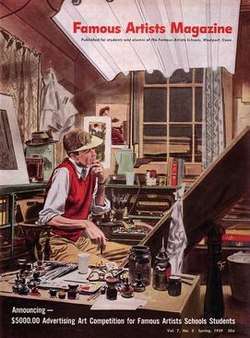Famous Artists School
Famous Artists School is an art correspondence course institution, in operation since 1948. The school was founded by members of the New York Society of Illustrators, principally Albert Dorne and Norman Rockwell.
| Subsidiary | |
| Industry | Education |
| Genre | Art |
| Founded | 1948 |
| Founder | Albert Dorne |
| Headquarters | |
Key people | Norman Rockwell |
| Parent | Cortina Learning International |
| Website | ArtHomeStudy.com |

History
The Famous Artists School was founded in 1948 in Westport, Connecticut, U.S.A. The idea was conceived by members of the New York Society of Illustrators (SOI), but due to the Society's legal status, could not be operated by it. SOI member Albert Dorne led the initiative to set up a separate entity, and recruited the support of Norman Rockwell, who was also an SOI member. For the founding faculty, Dorne recruited John Carlton Atherton, Austin Briggs, Stevan Dohanos, Robert Fawcett, Peter Helck, Fred Ludekens, Al Parker, Norman Rockwell, Ben Stahl, Harold von Schmidt and Jon Whitcomb.
By 1960, annual revenue of $7 million was eight times the sales of 1950. In the 1960s, the growth continued with the addition of Famous Photographers and an especially popular course, Famous Writers. European sales grew rapidly. By 1967, one officer said "we will soon have an empire on which the sun never sets." But acquisitions unrelated to art swelled the company's indebtedness, and a savage article by Jessica Mitford ripped Famous Writers for deceptive advertising and overblown promises.[1] In 1972 the company filed for bankruptcy.
The Famous Artists School was acquired by Cortina Learning International of Wilton, Connecticut, in 1981.
In 2014 the archives were donated to the Norman Rockwell Museum.[2][3]
According to a message displayed on the school's website, the school closed as of December 31, 2016. Textbooks are still offered for sale.[4]
Original courses
The original course offered in 1948 was Illustration & Design, with Painting and Cartooning added in the 1950s. The Painting and Illustration & Design courses, which are still offered, consisted of 24 lessons, with a new lesson mailed to the student upon completion of the previous lesson. When a student completed and returned the assignment, it was critiqued by a professional artist who sent suggestions to the student.
The original 1948 price for the three-year course was $200, payable at once or in monthly installments, and veterans could use the GI Bill.[5] By the 1950s the price was $300, plus an estimated $11.55 for basic oil painting supplies.[6]
References
- Mitford, Jessica (July 1970). "Let Us Now Appraise Famous Writers". The Atlantic. Retrieved 2018-01-06.
- Kennedy, Randy (March 23, 2014). "The Draw of a Mail-Order Art School: Famous Artists School Archives Go to Norman Rockwell Museum". New York Times.
- "In The News: Famous Artists School Archives". Norman Rockwell Museum. Retrieved 23 December 2014.
- "About Us:: Famous Artists School". arthomestudy.com. Retrieved 2018-01-06.
- Solomon, Deborah (2013). ""We're Looking for People Who Like to Draw" (October 1948)". American Mirror: the Life and Art of Norman Rockwell. New York: Farrar, Straus and Giroux. p. 243. ISBN 0374113092.
- Marling, Karal Ann (1994). As Seen on TV: The Visual Culture of Everyday Life in the 1950s. Cambridge, Massachusetts: Harvard University Press. pp. 73–74. ISBN 978-0674048836. Extract archived online; search "Famous" for cited pp. 72-73: Marling, Karal Ann. "Hyphenated Culture: Painting by Numbers in the New Age of Leisure". Le Salon de PAINT-BY-NUMBERS. Archived from the original on 2010-02-06.
External links
- "Famous Artists School home page". ; Old URL
- "The Artists Who Founded Famous Artists School". Famous Artists School.
- Worth, Stephen (January 15, 2014). "Instruction: Chad's Design For Television". Animation Resources, Inc.. Sample pages and discussion of volume 24 of the 1960 (second) edition of the Famous Artists Course, Television art, written by former Disney Studios animator and first (1938) television commercial producer, Chad Grothkopf.
- "Famous Artists School". Connecticut Historical Society. Archived from the original on August 12, 2009.